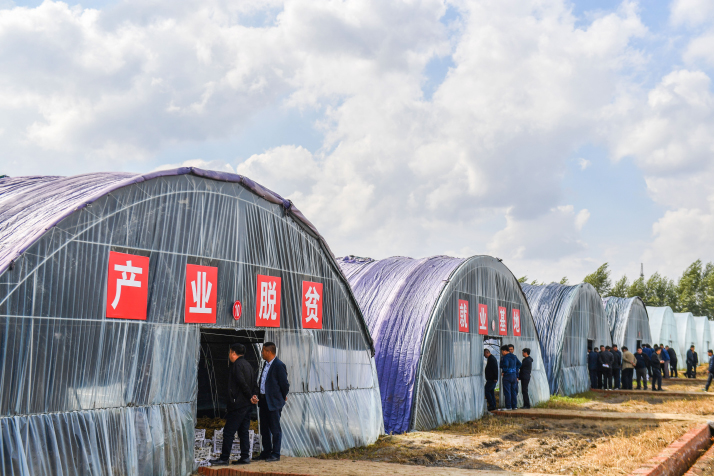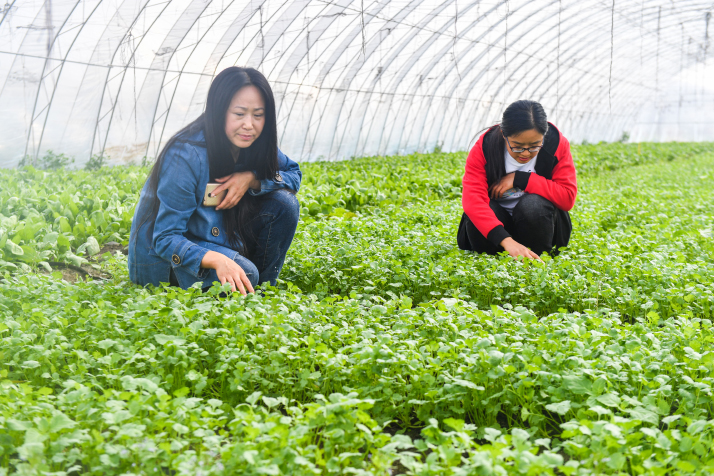Golden Green Farms
Beijing Review,November 03, 2018 Adjust font size:
A field study on greenhouse agriculture is carried out in Changsheng Village of Zhaodong, Suihua City in northeast China's Heilongjiang Province, on September 29 (WEI YAO)
With machines roaring, workers at a corn-processing factory in Xiangyang Village of Zhaodong, Suihua City in northeast China's Heilongjiang Province, were busy peeling, washing, boiling and then packaging corn.
Boxes containing corn piled up around the factory. Wang Zhongbao, the owner of the plant, was busy answering calls from people wanting to place orders. "Our production volume can't meet the growing demand," Wang said. "I have to turn most of them away. We are planning to expand the plant to a much larger scale."
Working as a barefoot doctor in the village for over a decade, Wang decided to start his own poultry-raising business in 2005. He started with 2,000 chickens and spent a lot of time learning from skilled villagers and veterinarians how to avoid diseases and raise healthier chickens that would produce more eggs. Within a few years, he expanded to 5,000 chickens and then to over 10,000, involving more villagers in the process.
In order to pool more labor and resources together, Wang initiated a large-scale poultry-raising cooperative in 2008, setting up standardized technical support, supply chains and prices. More than 100 households joined, increasing the number of chickens to 800,000 and adding 100,000 geese.
In the first year, each household in the cooperative earned over 30,000 yuan ($4,500) on average. By 2015, the total number of households involved had increased to 1,660, including some from other towns across the province.
When it was found that corn had such a large market, Wang expanded his business to include corn and other grains, setting up Wang Lao Bao Food Co. Ltd. in 2014. Today, the total assets of the company have surpassed 50 million yuan ($7.35 million) with net profits hitting 8 million yuan ($1.17 million) a year. More than 200 villagers are employed in the corn-processing factory during the busy season.
"Now we have 15,000 mu (1,000 hectares) of corn fields and we expect to expand," Wang said. With no additives or sugars involved in the processing, the corn is 100 percent organic and green, making it very popular with consumers even though it is not cheap. The market price for a regular ear of corn is normally 2 yuan ($0.3), but Wang's corn can sell for up to 9.8 yuan ($1.4), almost five times the average.
"The market for green and organic food has been increasing as more consumers become concerned about food safety. This is an opportunity for us to develop modern agriculture," Wang said. "I hope more villagers can explore more in this direction."
"We have greatly developed green and organic agriculture in recent years," Yin Cai, Deputy Director of the Zhaodong Bureau of Agriculture, told Beijing Review. "Among the total 3.7 million mu (246,67 hectares) of farmland, more than 1.1 million mu (73,333 hectares) is for green and organic farming."
Yin said that corn, the main crop in Zhaodong, is now following a healthier growing pattern. In the past, farmers paid a lot of attention to increasing the output volume by using chemical fertilizers, but this made the product more vulnerable to the market, since buyers had the final say on the price.
Now as farmers begin to pay more attention to increasing quality and focus on organic solutions and as more consumers are willing to pay more for organic food, those who produce quality crops are turning out to be the price controllers.
In the past, the price for regular millet was about 6 yuan ($0.88) per kg, but now, with more local companies involved in organic crop supply, the price of organic millet can surpass 40 yuan ($5.88).
Pan Shufan and her daughter Xiao Zhijie work in a greenhouse in Changsheng Village of Zhaodong on September 29 (WEI YAO)


cdfa6700-55c1-4239-ae3c-2327248faf90.jpg)
